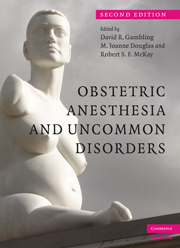Book contents
- Frontmatter
- Contents
- List of plates
- List of contributors
- Preface
- Section 1 Cardiovascular and respiratory disorders
- Section 2 Musculoskeletal disorders
- Section 3 Nervous system disorders
- Section 4 Metabolic disorders
- Section 5 Other disorders
- 17 Blood disorders
- 18 Infectious diseases in pregnancy
- 19 Dermatoses
- 20 Psychiatric disorders in pregnancy
- 21 Malignancy and pregnancy
- 22 Pregnancy and transplantation
- 23 Autoimmune diseases
- Index
- Plate Section
- References
22 - Pregnancy and transplantation
from Section 5 - Other disorders
Published online by Cambridge University Press: 19 October 2009
- Frontmatter
- Contents
- List of plates
- List of contributors
- Preface
- Section 1 Cardiovascular and respiratory disorders
- Section 2 Musculoskeletal disorders
- Section 3 Nervous system disorders
- Section 4 Metabolic disorders
- Section 5 Other disorders
- 17 Blood disorders
- 18 Infectious diseases in pregnancy
- 19 Dermatoses
- 20 Psychiatric disorders in pregnancy
- 21 Malignancy and pregnancy
- 22 Pregnancy and transplantation
- 23 Autoimmune diseases
- Index
- Plate Section
- References
Summary
Introduction
Transplantation is recognized as life saving for individuals suffering from end-stage organ failure. For many young women, improved transplant success rates and newer “obstetric-friendly” immunosuppressant drugs have allowed them the opportunity of achieving normal reproductive function, with the subsequent choice of childbearing. The most extensive experience with pregnancy in the posttransplant parturient has been in renal recipients with the first successful posttransplant pregnancy occurring in 1958. Since then, thousands of successful deliveries have been reported in women after liver, heart, simultaneous kidney–pancreas and combined transplants (heart–lung(s), liver–kidney, liver–heart, and liver–lung). Despite the inherent increased risk to the mother and concerns about the effects of immunosuppressive drugs on fetal development, and the effects of pregnancy on transplant function, a successful outcome in such pregnancies is achievable. Consensus is that in the presence of good graft function and with stable maintenance immunosuppressive drug therapy, pregnancy is well tolerated, with most pregnancies resulting in successful outcomes for mother and newborn. In addition, multiple pregnancies in a transplant recipient do not seem to increase the incidence of complications in the newborn or mother or augment graft dysfunction and failure.
Statistics
Organ transplantation has become a relatively common surgical procedure performed in over 250 centers worldwide, with improvement in both patient and graft survival rates reported over the past two decades. As such, many of these recipients are healthy and live a relatively normal life, with an excellent chance of survival during and beyond their reproductive years.
- Type
- Chapter
- Information
- Obstetric Anesthesia and Uncommon Disorders , pp. 381 - 404Publisher: Cambridge University PressPrint publication year: 2008



